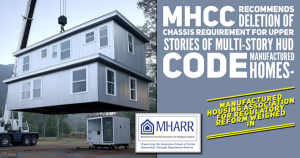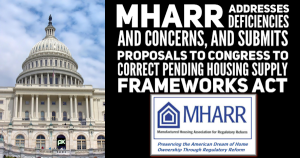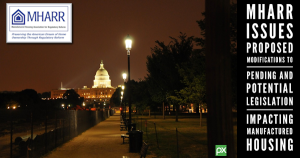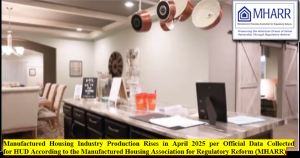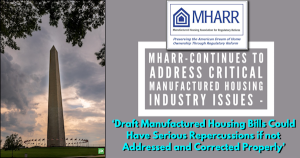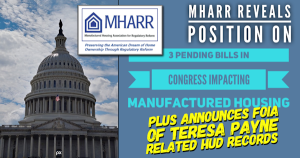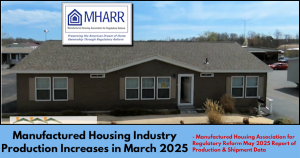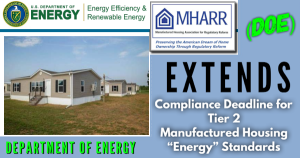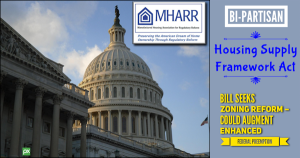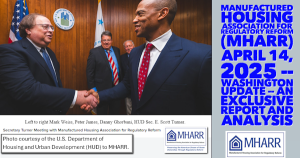“The Ultimate Battle Against Destructive Energy Regulation”
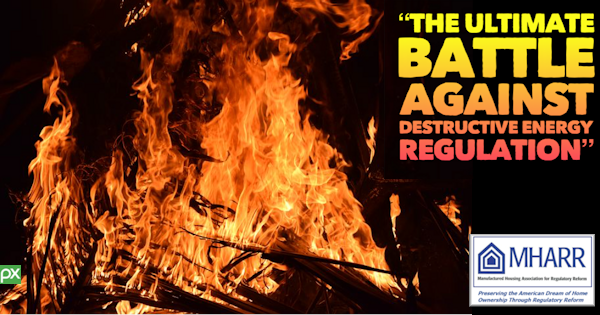
So, what could be worse than destructive, excessively costly federal manufactured housing “energy conservation” standards developed through a distorted and fundamentally tainted process at the U.S. Department of Energy (DOE)? The answer? Destructive and excessively costly manufactured housing “energy conservation” standards developed through two distorted and fundamentally tainted processes – one inside of DOE and one outside. Or, put differently, two layers of destructive, unnecessary and ultra-costly regulation for the price of just one. To fully understand how this now looms (once again) as a major threat to both the industry and its lower and moderate-income consumers, and how it must be stopped by the industry as a whole, read on.
The long and continuing manufactured housing “energy standards” saga dates back nearly 15 years, to the so-called Energy Independence and Security Act of 2007 (EISA). Section 413 of that sop to “energy conservation” special interests, essentially divests HUD of its authority over manufactured housing energy standards and transfers that authority to the affordable housing experts at DOE. The same section, moreover, instructs DOE (subject to certain limited exceptions) to develop energy conservation standards for manufactured homes “based on the most recent version of the International Energy Conservation Code” (IECC) developed and maintained by the Washington, D.C.-based International Code Council (ICC). EISA, consequently, explicitly ties energy standards for “affordable” federally-regulated manufactured homes to a high-cost “international” code for site-built structures, that for years has been controlled by state and local building officials. In other words, the final structure of the IECC, through everyiteration to date, has been controlled by officials that are federally preempted from regulating virtually every other aspect of manufactured housing construction and safety, and work for state and local governments that often are only too happy to exclude manufactured housing altogether, through discriminatory zoning measures.
To start with, let’s be clear that this law was, is, and always has been unnecessary, and based on the false premise that manufactured homes somehow lag in energy efficiency. As MHARR has consistently emphasized since the energy standards saga began, U.S. Census Bureau statistics show that monthly energy costs for HUD Code manufactured homes are actually less than site-built homes with resect to oil and piped natural gas, and only slightly higher than site-built homes for electricity usage. Consequently, the entire premise for new manufactured housing “energy conservation” standards is bogus, on a “whole house” basis (which is the only basis relevant to consumers). So is the energy special interests’ claim that costly new energy standards would somehow lead to “life cycle” savings that would ultimately benefit homeowners. To the contrary, a 2014 statistical analysis by the National Association of Home Builders (NAHB) (no friend of the manufactured housing industry) showed that for every $1,000 increase in the cost of a new manufactured home, more than 300,000 potential consumers are excluded from the market (a figure that would be even higher now). As a result, new “energy” standards that would add thousands of dollars to the retail cost of a new manufactured home (see, cost details below), would effectively exclude millions of potential lower and moderate-income consumers from the HUD Code market – a devastating blow to an industry that has sold fewer than 100,000 new homes per year since 2006. Moreover – and also as MHARR has continuously asserted — for the millions of potential consumers excluded from the HUD Code market by these excessive new “up-front” costs, there would be and could not possibly be any “life-cycle” savings whatsoever. For those excluded from the market altogether, there is no home, no homeownership, and no “life cycle.”
Regardless of these undeniable facts, DOE began the process to develop manufactured housing energy standards under EISA. What happened next has been explained and debunked many times by MHARR. DOE, after being thwarted by aggressive MHARR opposition between 2007 and 2011, ultimately developed a “draft” manufactured housing energy standard behind closed doors that was “impermissibly distributed” – as admitted by DOE’s Office of General Counsel (OGC) — to DOE energy special interest allies and the Manufactured Housing Institute (MHI) (the first sign of more problems to come). That 2011 “draft” standard, consistent with MHARR’s longstanding opposition, was later rejected by the Office of Management and Budget (OMB), and – again as admitted by its OGC — returned to DOE in 2013 with a directive to “start over.” Faced with the rejection of manufactured housing energy standards developed behind closed doors with non-public inputs from special interest allies, DOE and its partners devised a plan to railroad the same — or similar — proposed standards into law through a phony, contrived “negotiated rulemaking” process that would provide a veneer of legitimacy, while actually functioning as cover for DOE and its allies.
With this “wink and nod,” DOE moved forward with its phony “negotiated rulemaking.” What DOE and its collaborators did not count on, though, was MHARR’s continuing opposition, and its role as the only member of the DOE negotiated rulemaking “working group” not only to oppose that entire sham process from the start, but to demand transparency regarding both the illicit “negotiated rulemaking” process and everything that came before. This led to the entire sordid story, including MHI’s involvement, being unearthed and exposed by MHARR in August 2016 comments to DOE on the proposed standards developed through that phony, sham “process.” With MHARR thus: (1) casting the only “no” vote within the DOE “working group” (with no help from MHI, which voted “yes”) against those IECC-based standards that, according to MHARR estimates, would needlessly add thousands of dollars to the cost of a new manufactured home (see below); and (2) strenuously objecting to the adoption of any standard arising from the fundamentally tainted “negotiated rulemaking” process, DOE ultimately withdrew the 2016 proposed standard. Without consistent and aggressive MHARR opposition, however, the destructive, ultra-costly and ultimately fraudulent 2016 proposed standards would already have been law by now.
And those standards would have had a devastating impact on the industry and its ability to produce inherently affordable homes for mostly lower and moderate-income homebuyers. As estimated by MHARR, the 2016 DOE working group proposal and proposed 2016 standards, would have added more than $4,600 to the retail cost of a new single-section HUD Code home and more than $5,800 to the retail cost of a new double-section manufactured home. These figures, however: (1) are based on the 2015 version of the IECC; (2) are expressed in 2014 dollars; and (3) do not reflect any testing, compliance and/or enforcement costs under the proposed DOE standards, which were never considered or calculated by either the DOE working group, or DOE itself. Consequently, the costs estimated by MHARR during the “working group” process would necessarily be significantly lower than the comparable costs today. Moreover, even updated to 2021 dollars, those higher costs would pale in comparison to the costs that would result from following subsequent iterations of the IECC, as EISA section 413 would ultimately require. Thus, the figures noted above would only be the start of continuously spiraling price increases.
Following the withdrawal of the 2016 proposed rule, DOE, in 2018, floated a slightly less onerous standards proposal in a Notice of Data Availability (NODA). MHARR, however, objected once again, insofar as the 2018 proposal continued to rely on the same unproven and unreliable cost-benefit “data” and “analysis” derived from the fundamentally-tainted “negotiated rulemaking.” At the end of 2018, then, the DOE manufactured housing energy rulemaking was once again dead in the water, with the Trump Administration showing little or no interest in moving forward. Subsequently, though, the activist Sierra Club filed suit in federal court in Washington, D.C. to compel DOE to issue manufactured housing energy standards under EISA. The court, after rejecting DOE’s contention that the Sierra Club lacked legal “standing” to pursue its claims, entered a “consent order” which requires the promulgation of section 413 federal manufactured housing energy standards by DOE no later than May 14, 2021, and the adoption of final standards by no later than February 14, 2022. Thus, the continuing battle against unreasonable and excessively costly DOE manufactured housing “energy” standards continues and is poised to reach its “ultimate” stage, which shouldmake this a top priority for the entire industry to stop.
To date, DOE has offered no public indication of how it plans to proceed. Nor has there been any publicstandards development activity concerning manufactured homes since the Department’s 2018 NODA. What is known, however, is that DOE is being pressured by “energy” special interests to simply impose the fundamentally-tainted 2016 proposed standards. For example, a special interest participant in the phony DOE “negotiated rulemaking,” the American Council for an Energy Efficient Economy (ACEEE) (with funding support from the North American Insulation Manufacturers Association which, like other “energy” special interests, is obviously seeking to “legislate” new and additional revenue for its members), has called for the rapid re-promulgation of the phony, ultra-costly 2016 proposed standard, stating that: “The quickest way to set a better energy standard for manufactured homes is for DOE to issue the current draft [2016] standard, as it should not require a new analysis, a new [Notice of Proposed Rulemaking], or a public comment period.”
Needless to say, if that were to occur, MHARR would, again, aggressively oppose any such move, based – as it has done consistently — on the fundamentally-tainted process that led to the 2016 proposed standards, the excessive cost of those standards and their almost total lack of benefits for consumers over the typical ownership tenure of a mainstream manufactured home. Moreover, given the dire consequences that those phony, ultra-costly standards would have for both the industry and its customer base, a court action to invalidate the entire fundamentally-tainted “negotiated rulemaking” process and any and all actions arising from or out of that process will need united industry support.
Meanwhile, though, an entirely new issue has emerged with respect to the EISA section 413 tie-in between manufactured housing energy standards and the IECC. Specifically, “manipulation” and “abuse” of the IECC process by energy special interests (sound familiar?) during the most recent 2021 revision cycle, which led first to an open revolt against the IECC by site-builders, and now, to significant changes to the IECC process. Those changes, however, are not even close to a cure for the fatal flaws that make the IECC totally inappropriate and unacceptable as a basis for any manufactured housing energy standards.
The IECC, until now, has been developed, maintained and updated through a “governmental code process” where the final votes on proposed changes and additions, are cast exclusively by ICC-approved state and/or local government officials (i.e., other interest groups had no say whatsoever, in the final provisions of the code). In a February 2, 2021 letter to Congress, ICC explained the IECC process as follows: “[V]olunteer government officials with experience and expertise exercise by far the most control in the process. Volunteer [state and local] government officials have the final vote on any proposed code change.” (Emphasis added). Thus, while industry and consumer stakeholders could participate in the IECC committee process, they had no vote at all on the final code, and it is the abuse of this anomaly that spurred the homebuilder “revolt” to scrap the “governmental” process and switch to an ANSI (American National Standards Institute)-based consensus standards-development process that would allow all interest groups (like those within the Manufactured Housing Consensus Committee) to vote on final proposals.
Specifically, the 2021 IECC revision process saw multiple high-cost proposals that were previously rejected within IECC committees, reinstated and adopted, during the final government-official-only vote after a behind-the-scenes campaign by energy special interests (again, sound familiar?) to lobby and pressure those government officials to cast votes in favor of the previously-rejected proposals. An NAHB ally, Leading Builders of America (LBA), explained this “manipulation” of the IECC process in a January 26, 2021 letter, stating: “For the building community, the 2021 [IECC] update is a cause for serious concern. Multiple code changes were approved that will increase the cost of a new home by up to $10,000 with only modest savings for consumers. Some of the new requirements have payback periods over 100 years. Each of these ‘high-cost-low-benefit’ code changes were twice rejected during the code development process. They were approved as a result of an unprecedented effort to manipulate the ICC’s governmental online consensus vote.” (Emphasis added). (Yet again, sound familiar?) To support these claims, LBA provided recordings of conference calls with special interest activists lobbing government official voters to follow a cheat-sheet “voting guide” showing the previously-rejected proposals the activists sought to have reinstated and adopted in the final vote.
As a result of this “political manipulation,” the ICC Board of Directors, just weeks ago, voted to convert the IECC from a government code process to an American National Standards Institute (ANSI)-based consensus process, similar to that of the statutory Manufactured Housing Consensus Committee, with equally-balanced committees andvoting. Under the Board’s decision, however, this change will not become effective until the 2024 revision process begins. And even though the 2024 (and beyond) process will change because of the special interest “manipulation” now confirmed through the decision of ICC’s Board, the Board incongruously decided to keep in place not only the “politically manipulated” and thus tainted 2021 revisions adopted through the “government only” system then in place, but all of the IECC provisions previously approved through that same tainted and flawed system. The Executive Summary of the ICC Board’s decision thus states: “The 2024 IECC will start from the content of the 2021 IECC.” (Emphasis added). While thus acknowledging the validity of the claims of a fundamentally-tainted process, the ICC Board’s decision would leave the results of that tainted process in place as a springboard to further contaminate future IECC revisions that would build upon a fundamentally-tainted “foundation.”
For the HUD Code industry, this ICC Board decision is more important for what it shows than what it does. What it shows is that the IECC, developed through 2021 via a process that has been “abused” and “manipulated” to require measures that are excessively-costly and produce no positive results for consumers over a normal homeownership tenure period, is not now, never has been, and never could be a proper or legitimate basis for manufactured housing energy standards.
First, as noted above, manufactured homes are already energy-efficient. Second, no aspect of manufactured housing regulation should be based on a code that for years has been under the exclusive control of officials employed by state and/or local governments that: (1) exclude or otherwise discriminate against manufactured homes and manufactured homebuyers; and (2) have no direct experience, knowledge, or expertise regarding manufactured home construction or regulation. Third, federal law mandates that manufactured housing be “affordable” and that any and all manufactured housing regulation under authority of federal law take into consideration and maintain that affordability. The IECC, however, has never been subject to any such (or equivalent) mandate.
Thus, as emphasized by LBA, the IECC process has resulted in “pie-in-the-sky” energy mandates with extreme up-front cost impacts (costing $10,000 or more for a site-built home just in the 2021 revision) that cannot be recovered under the reasonable occupancy tenure of a site-built home or, worse yet, an affordable manufactured home. (Again, sound familiar?).
As a result, EISA section 413, tying manufactured housing energy standards to the IECC was, and is, a serious mistake that will needlessly exclude millions of lower and moderate-income homebuyers from the American Dream of homeownership, and subject still others to the miseries of homelessness and all of its costs, both individual and societal. Consequently, EISA-based manufactured housing energy standards, such as the proposed 2016 standards (or worse) must be stopped. MHARR is and always has been committed to such an effort. And given the fact that MHI has more recently recognized the destructive nature and likely impact of DOE’s 2016 proposed rule, it must also be prepared to aggressively oppose this baseless attack on the industry, its product, and its consumers.
Mark Weiss
MHARR is a Washington, D.C.-based national trade association representing the views and interests of independent producers of federally-regulated manufactured housing.
“MHARR-Issues and Perspectives” is available for re-publication in full (i.e., without alteration or substantive modification) without further permission and with proper attribution to MHARR.

So, what could be worse than destructive, excessively costly federal manufactured housing “energy conservation” standards developed through a distorted and fundamentally tainted process at the U.S. Department of Energy (DOE)? The answer? Destructive and excessively costly manufactured housing “energy conservation” standards developed through two distorted and fundamentally tainted processes – one inside of DOE and one outside. Or, put differently, two layers of destructive, unnecessary and ultra-costly regulation for the price of just one. To fully understand how this now looms (once again) as a major threat to both the industry and its lower and moderate-income consumers, and how it must be stopped by the industry as a whole, read on.
The long and continuing manufactured housing “energy standards” saga dates back nearly 15 years, to the so-called Energy Independence and Security Act of 2007 (EISA). Section 413 of that sop to “energy conservation” special interests, essentially divests HUD of its authority over manufactured housing energy standards and transfers that authority to the affordable housing experts at DOE. The same section, moreover, instructs DOE (subject to certain limited exceptions) to develop energy conservation standards for manufactured homes “based on the most recent version of the International Energy Conservation Code” (IECC) developed and maintained by the Washington, D.C.-based International Code Council (ICC). EISA, consequently, explicitly ties energy standards for “affordable” federally-regulated manufactured homes to a high-cost “international” code for site-built structures, that for years has been controlled by state and local building officials. In other words, the final structure of the IECC, through everyiteration to date, has been controlled by officials that are federally preempted from regulating virtually every other aspect of manufactured housing construction and safety, and work for state and local governments that often are only too happy to exclude manufactured housing altogether, through discriminatory zoning measures.
To start with, let’s be clear that this law was, is, and always has been unnecessary, and based on the false premise that manufactured homes somehow lag in energy efficiency. As MHARR has consistently emphasized since the energy standards saga began, U.S. Census Bureau statistics show that monthly energy costs for HUD Code manufactured homes are actually less than site-built homes with resect to oil and piped natural gas, and only slightly higher than site-built homes for electricity usage. Consequently, the entire premise for new manufactured housing “energy conservation” standards is bogus, on a “whole house” basis (which is the only basis relevant to consumers). So is the energy special interests’ claim that costly new energy standards would somehow lead to “life cycle” savings that would ultimately benefit homeowners. To the contrary, a 2014 statistical analysis by the National Association of Home Builders (NAHB) (no friend of the manufactured housing industry) showed that for every $1,000 increase in the cost of a new manufactured home, more than 300,000 potential consumers are excluded from the market (a figure that would be even higher now). As a result, new “energy” standards that would add thousands of dollars to the retail cost of a new manufactured home (see, cost details below), would effectively exclude millions of potential lower and moderate-income consumers from the HUD Code market – a devastating blow to an industry that has sold fewer than 100,000 new homes per year since 2006. Moreover – and also as MHARR has continuously asserted — for the millions of potential consumers excluded from the HUD Code market by these excessive new “up-front” costs, there would be and could not possibly be any “life-cycle” savings whatsoever. For those excluded from the market altogether, there is no home, no homeownership, and no “life cycle.”
Regardless of these undeniable facts, DOE began the process to develop manufactured housing energy standards under EISA. What happened next has been explained and debunked many times by MHARR. DOE, after being thwarted by aggressive MHARR opposition between 2007 and 2011, ultimately developed a “draft” manufactured housing energy standard behind closed doors that was “impermissibly distributed” – as admitted by DOE’s Office of General Counsel (OGC) — to DOE energy special interest allies and the Manufactured Housing Institute (MHI) (the first sign of more problems to come). That 2011 “draft” standard, consistent with MHARR’s longstanding opposition, was later rejected by the Office of Management and Budget (OMB), and – again as admitted by its OGC — returned to DOE in 2013 with a directive to “start over.” Faced with the rejection of manufactured housing energy standards developed behind closed doors with non-public inputs from special interest allies, DOE and its partners devised a plan to railroad the same — or similar — proposed standards into law through a phony, contrived “negotiated rulemaking” process that would provide a veneer of legitimacy, while actually functioning as cover for DOE and its allies.
With this “wink and nod,” DOE moved forward with its phony “negotiated rulemaking.” What DOE and its collaborators did not count on, though, was MHARR’s continuing opposition, and its role as the only member of the DOE negotiated rulemaking “working group” not only to oppose that entire sham process from the start, but to demand transparency regarding both the illicit “negotiated rulemaking” process and everything that came before. This led to the entire sordid story, including MHI’s involvement, being unearthed and exposed by MHARR in August 2016 comments to DOE on the proposed standards developed through that phony, sham “process.” With MHARR thus: (1) casting the only “no” vote within the DOE “working group” (with no help from MHI, which voted “yes”) against those IECC-based standards that, according to MHARR estimates, would needlessly add thousands of dollars to the cost of a new manufactured home (see below); and (2) strenuously objecting to the adoption of any standard arising from the fundamentally tainted “negotiated rulemaking” process, DOE ultimately withdrew the 2016 proposed standard. Without consistent and aggressive MHARR opposition, however, the destructive, ultra-costly and ultimately fraudulent 2016 proposed standards would already have been law by now.
And those standards would have had a devastating impact on the industry and its ability to produce inherently affordable homes for mostly lower and moderate-income homebuyers. As estimated by MHARR, the 2016 DOE working group proposal and proposed 2016 standards, would have added more than $4,600 to the retail cost of a new single-section HUD Code home and more than $5,800 to the retail cost of a new double-section manufactured home. These figures, however: (1) are based on the 2015 version of the IECC; (2) are expressed in 2014 dollars; and (3) do not reflect any testing, compliance and/or enforcement costs under the proposed DOE standards, which were never considered or calculated by either the DOE working group, or DOE itself. Consequently, the costs estimated by MHARR during the “working group” process would necessarily be significantly lower than the comparable costs today. Moreover, even updated to 2021 dollars, those higher costs would pale in comparison to the costs that would result from following subsequent iterations of the IECC, as EISA section 413 would ultimately require. Thus, the figures noted above would only be the start of continuously spiraling price increases.
Following the withdrawal of the 2016 proposed rule, DOE, in 2018, floated a slightly less onerous standards proposal in a Notice of Data Availability (NODA). MHARR, however, objected once again, insofar as the 2018 proposal continued to rely on the same unproven and unreliable cost-benefit “data” and “analysis” derived from the fundamentally-tainted “negotiated rulemaking.” At the end of 2018, then, the DOE manufactured housing energy rulemaking was once again dead in the water, with the Trump Administration showing little or no interest in moving forward. Subsequently, though, the activist Sierra Club filed suit in federal court in Washington, D.C. to compel DOE to issue manufactured housing energy standards under EISA. The court, after rejecting DOE’s contention that the Sierra Club lacked legal “standing” to pursue its claims, entered a “consent order” which requires the promulgation of section 413 federal manufactured housing energy standards by DOE no later than May 14, 2021, and the adoption of final standards by no later than February 14, 2022. Thus, the continuing battle against unreasonable and excessively costly DOE manufactured housing “energy” standards continues and is poised to reach its “ultimate” stage, which shouldmake this a top priority for the entire industry to stop.
To date, DOE has offered no public indication of how it plans to proceed. Nor has there been any publicstandards development activity concerning manufactured homes since the Department’s 2018 NODA. What is known, however, is that DOE is being pressured by “energy” special interests to simply impose the fundamentally-tainted 2016 proposed standards. For example, a special interest participant in the phony DOE “negotiated rulemaking,” the American Council for an Energy Efficient Economy (ACEEE) (with funding support from the North American Insulation Manufacturers Association which, like other “energy” special interests, is obviously seeking to “legislate” new and additional revenue for its members), has called for the rapid re-promulgation of the phony, ultra-costly 2016 proposed standard, stating that: “The quickest way to set a better energy standard for manufactured homes is for DOE to issue the current draft [2016] standard, as it should not require a new analysis, a new [Notice of Proposed Rulemaking], or a public comment period.”
Needless to say, if that were to occur, MHARR would, again, aggressively oppose any such move, based – as it has done consistently — on the fundamentally-tainted process that led to the 2016 proposed standards, the excessive cost of those standards and their almost total lack of benefits for consumers over the typical ownership tenure of a mainstream manufactured home. Moreover, given the dire consequences that those phony, ultra-costly standards would have for both the industry and its customer base, a court action to invalidate the entire fundamentally-tainted “negotiated rulemaking” process and any and all actions arising from or out of that process will need united industry support.
Meanwhile, though, an entirely new issue has emerged with respect to the EISA section 413 tie-in between manufactured housing energy standards and the IECC. Specifically, “manipulation” and “abuse” of the IECC process by energy special interests (sound familiar?) during the most recent 2021 revision cycle, which led first to an open revolt against the IECC by site-builders, and now, to significant changes to the IECC process. Those changes, however, are not even close to a cure for the fatal flaws that make the IECC totally inappropriate and unacceptable as a basis for any manufactured housing energy standards.
The IECC, until now, has been developed, maintained and updated through a “governmental code process” where the final votes on proposed changes and additions, are cast exclusively by ICC-approved state and/or local government officials (i.e., other interest groups had no say whatsoever, in the final provisions of the code). In a February 2, 2021 letter to Congress, ICC explained the IECC process as follows: “[V]olunteer government officials with experience and expertise exercise by far the most control in the process. Volunteer [state and local] government officials have the final vote on any proposed code change.” (Emphasis added). Thus, while industry and consumer stakeholders could participate in the IECC committee process, they had no vote at all on the final code, and it is the abuse of this anomaly that spurred the homebuilder “revolt” to scrap the “governmental” process and switch to an ANSI (American National Standards Institute)-based consensus standards-development process that would allow all interest groups (like those within the Manufactured Housing Consensus Committee) to vote on final proposals.
Specifically, the 2021 IECC revision process saw multiple high-cost proposals that were previously rejected within IECC committees, reinstated and adopted, during the final government-official-only vote after a behind-the-scenes campaign by energy special interests (again, sound familiar?) to lobby and pressure those government officials to cast votes in favor of the previously-rejected proposals. An NAHB ally, Leading Builders of America (LBA), explained this “manipulation” of the IECC process in a January 26, 2021 letter, stating: “For the building community, the 2021 [IECC] update is a cause for serious concern. Multiple code changes were approved that will increase the cost of a new home by up to $10,000 with only modest savings for consumers. Some of the new requirements have payback periods over 100 years. Each of these ‘high-cost-low-benefit’ code changes were twice rejected during the code development process. They were approved as a result of an unprecedented effort to manipulate the ICC’s governmental online consensus vote.” (Emphasis added). (Yet again, sound familiar?) To support these claims, LBA provided recordings of conference calls with special interest activists lobbing government official voters to follow a cheat-sheet “voting guide” showing the previously-rejected proposals the activists sought to have reinstated and adopted in the final vote.
As a result of this “political manipulation,” the ICC Board of Directors, just weeks ago, voted to convert the IECC from a government code process to an American National Standards Institute (ANSI)-based consensus process, similar to that of the statutory Manufactured Housing Consensus Committee, with equally-balanced committees andvoting. Under the Board’s decision, however, this change will not become effective until the 2024 revision process begins. And even though the 2024 (and beyond) process will change because of the special interest “manipulation” now confirmed through the decision of ICC’s Board, the Board incongruously decided to keep in place not only the “politically manipulated” and thus tainted 2021 revisions adopted through the “government only” system then in place, but all of the IECC provisions previously approved through that same tainted and flawed system. The Executive Summary of the ICC Board’s decision thus states: “The 2024 IECC will start from the content of the 2021 IECC.” (Emphasis added). While thus acknowledging the validity of the claims of a fundamentally-tainted process, the ICC Board’s decision would leave the results of that tainted process in place as a springboard to further contaminate future IECC revisions that would build upon a fundamentally-tainted “foundation.”
For the HUD Code industry, this ICC Board decision is more important for what it shows than what it does. What it shows is that the IECC, developed through 2021 via a process that has been “abused” and “manipulated” to require measures that are excessively-costly and produce no positive results for consumers over a normal homeownership tenure period, is not now, never has been, and never could be a proper or legitimate basis for manufactured housing energy standards.
First, as noted above, manufactured homes are already energy-efficient. Second, no aspect of manufactured housing regulation should be based on a code that for years has been under the exclusive control of officials employed by state and/or local governments that: (1) exclude or otherwise discriminate against manufactured homes and manufactured homebuyers; and (2) have no direct experience, knowledge, or expertise regarding manufactured home construction or regulation. Third, federal law mandates that manufactured housing be “affordable” and that any and all manufactured housing regulation under authority of federal law take into consideration and maintain that affordability. The IECC, however, has never been subject to any such (or equivalent) mandate.
Thus, as emphasized by LBA, the IECC process has resulted in “pie-in-the-sky” energy mandates with extreme up-front cost impacts (costing $10,000 or more for a site-built home just in the 2021 revision) that cannot be recovered under the reasonable occupancy tenure of a site-built home or, worse yet, an affordable manufactured home. (Again, sound familiar?).
As a result, EISA section 413, tying manufactured housing energy standards to the IECC was, and is, a serious mistake that will needlessly exclude millions of lower and moderate-income homebuyers from the American Dream of homeownership, and subject still others to the miseries of homelessness and all of its costs, both individual and societal. Consequently, EISA-based manufactured housing energy standards, such as the proposed 2016 standards (or worse) must be stopped. MHARR is and always has been committed to such an effort. And given the fact that MHI has more recently recognized the destructive nature and likely impact of DOE’s 2016 proposed rule, it must also be prepared to aggressively oppose this baseless attack on the industry, its product, and its consumers.
Mark Weiss
MHARR is a Washington, D.C.-based national trade association representing the views and interests of independent producers of federally-regulated manufactured housing.
“MHARR-Issues and Perspectives” is available for re-publication in full (i.e., without alteration or substantive modification) without further permission and with proper attribution to MHARR.


